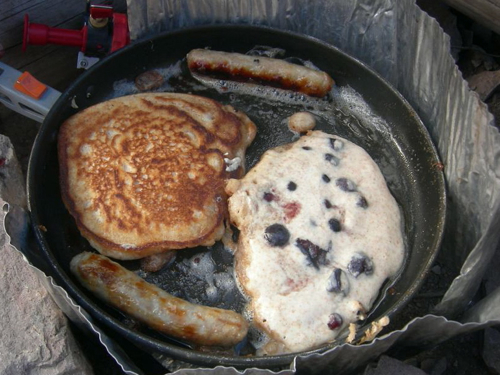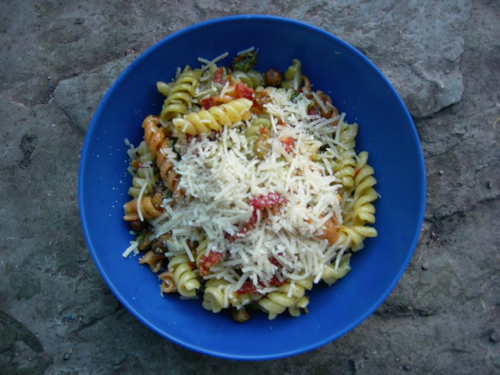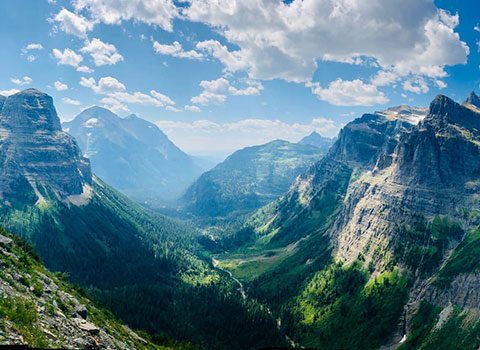One of the most common questions I get about guiding is “How does Glacier National Park backcountry cooking work?” So, in this week’s blog, I’m sharing some of my best tips and tricks for cooking amazing food in the middle of nowhere. Today I present you with …
Glacier National Park Backcountry Cooking Made Easy
Nothing works up an appetite like hauling yourself and a burly pack around in the mountains all day, and if you’ve ever hiked with me, you know that one of my favorite things about backpacking is the food. Sure, the staggering beauty of the mountains, the solitude, the peaceful pace of nature, and the feeling of accomplishment are all priceless, but to me, the food is a big deal. As a guide in Glacier National Park, few things are as satisfying as whipping up a seemingly impossible meal in the backcountry for a group of ravenous hikers. Nothing warms my heart like a smiling guest wolfing down one of my culinary creations and exclaiming, “I can’t believe I’m eating this on a camping trip,” or “so much for my plan to lose weight backpacking,” as they pass me their bowl for a second helping. Glacier National Park backcountry cooking is so much fun for me.

If you’re like me, you can’t live without pancakes. Throw some pancake mix into a sealable storage bag, and when it’s time for breakfast, add water, cut one of the corners off the bottom, and squeeze the batter into your pan. Photo by Brian Tuell.
Don’t get me wrong. There’s a time and a place to subsist on nothing but a jar of peanut butter and some jerky, but far too many hikers out there believe that choking down preservative-filled, freeze-dried meals and bland oatmeal is an integral part of the backcountry experience. I’m here to tell you that isn’t the case. You don’t have to compromise taste or health just because the nearest kitchen is a three day’s walk away. With a few simple tricks and a handful of versatile ingredients, you can eat some of the best meals of your life in the mountains.
Prep Work is Everything.
Write out your menu and figure out what meals work best each day. Know which days you have time for elaborate meals and which days you need to wolf down a bowl of granola and hit the trail. Slice, dice, pre-mix, and add spices while packing whenever possible. Most veggies keep just as well in slices as they do whole, and your pack will be lighter if you eliminate unusable seeds, stems, and edges. Want scrambled eggs one morning? Mix and spice the eggs, then pack them in a sealable container so all you have to do is pour them into your cooking pan.

Embrace your inner Iron Chef and chop those veggies beforehand. It’ll save you time in the backcountry and make your pack lighter. Who doesn’t love that?
The Freezer is Your Friend
Many people avoid meat while backpacking because it’s difficult to manage, but you don’t have to skip it. In fact, I frequently serve grilled chicken, shrimp, and sausage in my Glacier National Park backcountry cooking . All you have to do is cook it ahead of time, freeze it, and then warm it up at mealtime. Cheese, eggs, and butter also freeze well, and having frozen items in your food bag will help keep other fresh items cold. (To avoid messy leaks, keep in mind that liquid expands when frozen, so leave a little room in your container when freezing things like eggs.)
Pro Tip: I typically carry a lunch-box sized soft cooler in my pack to maintain cold items, but you probably already have what you need in your closet. Wrapping cold food in a quality polar fleece works equally well. Just be sure to put a layer of plastic (like a small trash bag) in between the food and the insulation layer to keep condensation from making your fleece, and everything else in your pack soggy.
Go Nuts.
Meat isn’t the only way to get protein. You can make hearty, delicious curry by adding a few handfuls of cashews when stir-frying your veggies, or top off an Italian-style pesto dish with pistachios to give your body the salt and protein it’s craving after an epic day in the mountains.

Cashews are a great way to get the extra protein you need while hiking. Here, I’ve added them to ginger and garlic stir-fried shrimp and veggies with coconut curry sauce . Photo by Colleen Warren.
Nuts aren’t just good for dinner either. Since I’m not a fan of oatmeal, I typically start with quinoa, rice, or couscous then add pecans or sliced almonds, dried fruit, and a dash of cinnamon or brown sugar. Don’t forget, add all that stuff to your grain of choice in your kitchen, rather than hauling your spice rack with you into the woods.
Know What Holds up Well.
Veggies and fruit: Broccoli, zucchini, carrots, snow peas, and kale hold up when sliced ahead of time. Bell peppers, mushrooms, and even spinach hold up surprisingly well also, but they should be packed with a paper towel to absorb excess moisture. Cucumbers and avocados pack well but should not be sliced until it’s time to eat them. Fresh fruits like apples, oranges, and blueberries last without refrigeration and are a welcome treat several days into a backcountry excursion.

Salty pistachios, savory sun dried tomatoes, parmesan, and a fresh basil garnish make pasta irresistible to a hungry hiker. Photo by Brian Tuell.
Other items: Hard, low moisture cheeses like parmesan are your best bet in the backcountry, and you can even add a little shredded parmesan to a bag of cheddar or mozzarella to prevent other types of cheese from sticking together. Also, fresh spices, wrapped in a paper towel and sealed in a storage bag, will keep for days and are an effortless way to give any meal a gourmet touch. For versatility and durability, you can’t beat cilantro, basil, and mint.
When it comes to cooking, wherever you are, it’s all about creativity and having fun with your ingredients. Don’t be afraid to experiment with your Glacier National Park backcountry cooking . Take these ideas and make them your own. Make them better, then send me pictures of your creations, or better yet, I’ll meet you out there and we can whip something up together!


